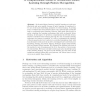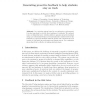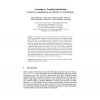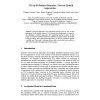ITS
2010
Springer
14 years 4 months ago
2010
Springer
Accelerated future learning, in which learning proceeds more effectively and more rapidly because of prior learning, is considered to be one of the most interesting measures of ro...
ITS
2010
Springer
14 years 4 months ago
2010
Springer
In a tutoring system based on an exploratory environment, it is also important to provide direct guidance to students. We endowed iList, our linked list tutor, with the ability to ...
ITS
2010
Springer
14 years 4 months ago
2010
Springer
The purpose of the current study was to test whether we could create a system where students can learn by teaching a live machine-learning agent. SimStudent is a computer agent tha...
ITS
2010
Springer
14 years 4 months ago
2010
Springer
A key promise of narrative-centered learning environments is the ability to make learning engaging. However, there is concern that learning and engagement may be at odds in these g...
ITS
2010
Springer
14 years 4 months ago
2010
Springer
We present an innovative application of discourse processing concepts to educational technology. In our corpus analysis of peer learning dialogues, we found that initiative and in...
ITS
2010
Springer
14 years 4 months ago
2010
Springer
The traditional, well established approach to finding out what works in education research is to run a randomized controlled trial (RCT) using a standard pretest and posttest desig...
ITS
2010
Springer
14 years 4 months ago
2010
Springer
Classical approaches for supporting tutoring services face several limitations for ill-defined domains. To overcome these limitations, we argue for the utilization of hybrid approa...
ITS
2010
Springer
14 years 4 months ago
2010
Springer
The deteriorating patient activity (DPA) is a low-fidelity educational simulation that prepares medical students to effectively approach emergency situations. This paper outlines h...
ITS
2010
Springer
14 years 4 months ago
2010
Springer
The use of technology for instruction, and the enormous amount of information available for consumption, places a considerable burden on instructors who must learn to integrate app...
ITS
2010
Springer
14 years 4 months ago
2010
Springer
Mily’s World is a learning environment for coordinate geometry that has game-like properties, that is, elements of games that are engaging such as cover story, graphical represen...




